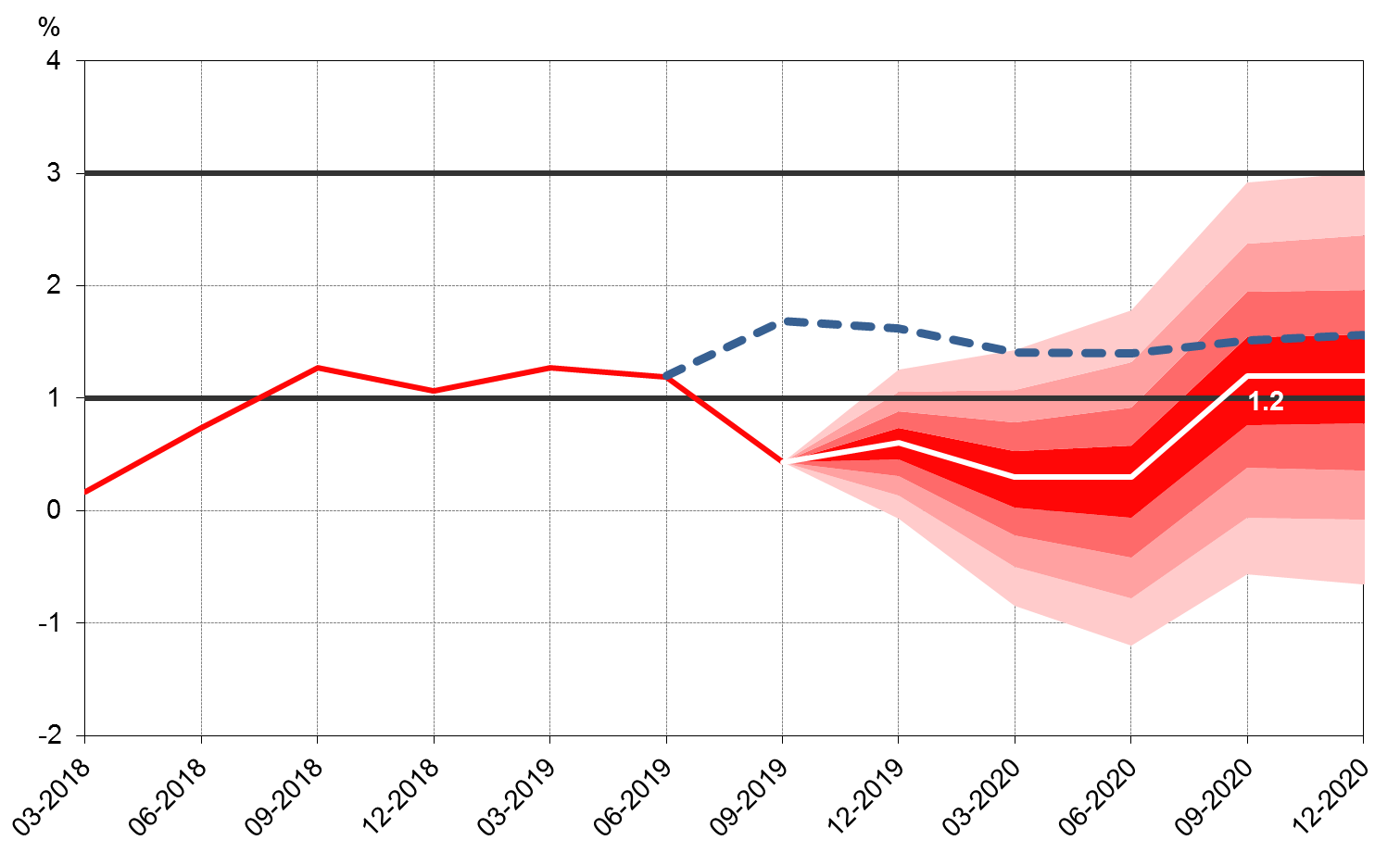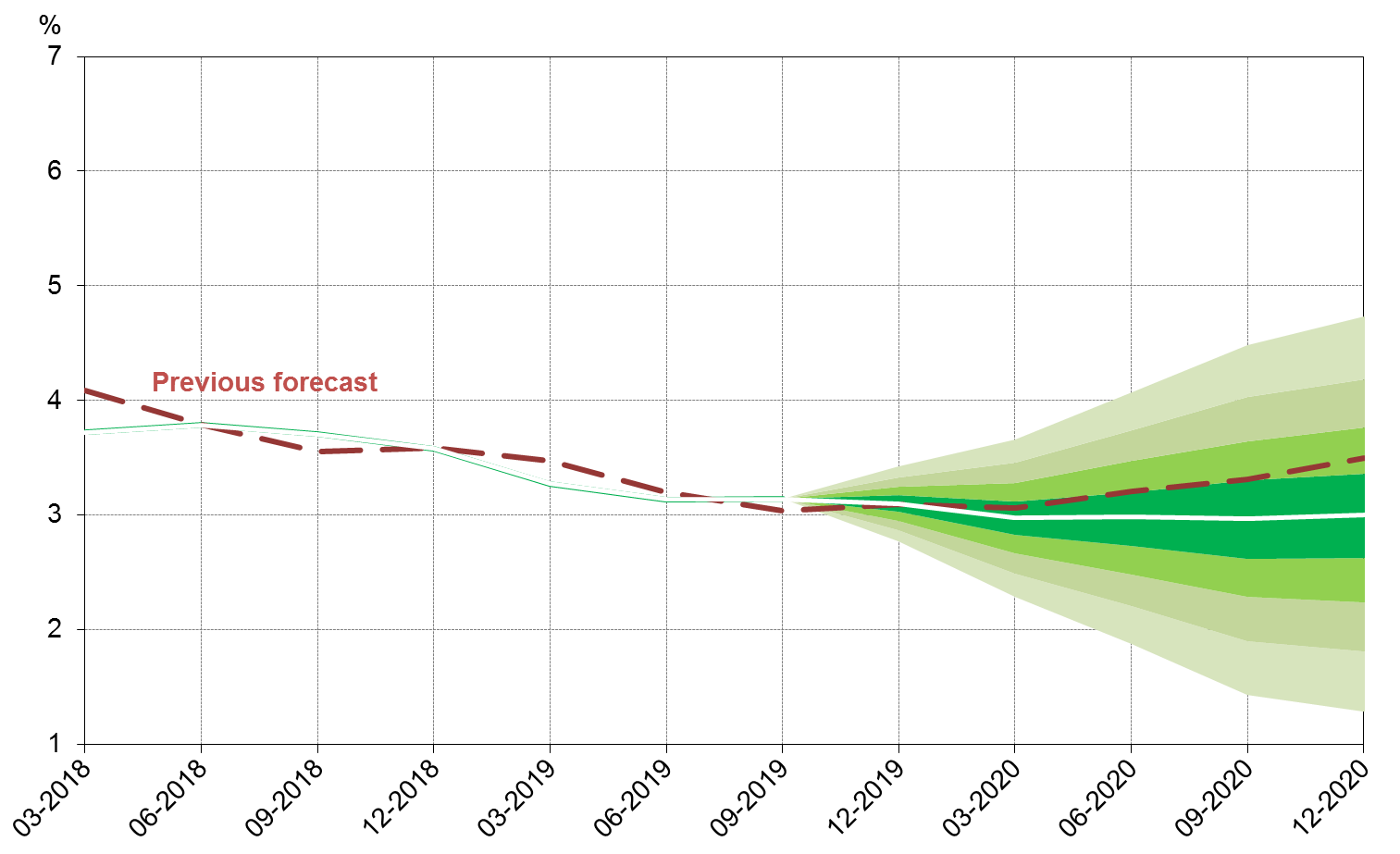This document presents the forecast of macroeconomic developments compiled by the Bank of Israel Research Department in October 2019[1] regarding the main macroeconomic variables—GDP, inflation and the interest rate. According to the staff forecast, gross domestic product (GDP) is projected to increase by 3.1 percent in 2019, similar to the previous forecast, and by 3.0 percent in 2020, lower than the previous forecast. The inflation rate in the four quarters ending in the third quarter of 2020 is expected to be 1.2 percent, lower than the previous forecast. The Bank of Israel interest rate in one year is expected to be 0.25 percent or to decline during the year to 0.1 percent.
Forecast
The Bank of Israel Research Department compiles a staff forecast of macroeconomic developments on a quarterly basis. The staff forecast is based on several models, various data sources, and assessments based on economists’ judgment.[2] The Bank’s DSGE (Dynamic Stochastic General Equilibrium) model developed in the Research Department—a structural model based on microeconomic foundations—plays a primary role in formulating the macroeconomic forecast.[3] The model provides a framework for analyzing the forces that have an effect on the economy, and allows information from various sources to be combined into a macroeconomic forecast of real and nominal variables, with an internally consistent “economic story”.
a. The global environment
Our assessments of expected developments in the global economy are based mainly on projections by international institutions and by foreign investment houses. We assume that growth in advanced economies will be about 1.5 percent in 2019 and 1.3 percent in 2020, lower than the assumption in the previous forecast. Accordingly, we have revised the assumption of global imports downward for both years. Our assumption is that inflation in the advanced economies will total 1.6 percent in 2019 and 1.7 percent 2020, slightly lower than our previous assumptions. According to the average of investment houses' most recent assessments before the forecast was prepared, the US federal funds rate is expected to decline to about 1.7 percent during 2020, and the interest rate in the eurozone is expected to remain at its current level until the end of 2020. The average price of Brent crude oil was about $62 per barrel in the third quarter of 2019. The price increased sharply during the quarter following the attack on the Saudi oil facilities, but then dropped back to its normal level during the quarter.
b. Real activity in Israel
GDP is expected to grow by 3.1 percent in 2019 and by 3.0 percent in 2020 (Table 1). There is no change in our general assessment that the economy is in a full employment environment, and GDP is growing at around its potential rate. Compared to the previous forecast, the investment forecast for 2019 was lowered slightly following National Accounts data for the second quarter of 2019, which indicated a growth rate lower than our previous assessment. The forecast of exports for 2019 was raised slightly, following actual data that indicated more rapid growth than our previous assessment.
For 2020, our assumption is that the new government will take measures to lower the deficit. Accordingly, we have lowered the forecast of growth in public consumption by 1 percentage point for that year, as the growth rate of public expenditure should slow. In addition, we assume that measures will also be taken to increase the revenue side, and we therefore lowered the forecast of private consumption by one percentage point. The export forecast for 2020 was also lowered, due to the decline in the forecast of global imports, which is partly offset by an upward revision in our assessment of the activity of a number of large companies in the economy. Consistent with these revisions, we lowered the growth forecast for 2020 by half a percentage point to 3.0 percent. Fixed capital formation is expected to decline in 2020 as a result of the conclusion of a number of large investments in the economy. Since these investments are import-intensive, their completion is expected to make a negative contribution to imports such that imports are expected to grow at the relatively moderate rate of just 0.5 percent in 2020.
Table 1 Economic Indicators Research Department Staff Forecast for 2019–2020 (rates of change, percent, unless stated otherwise) |
|||||
|
|
2018a |
Bank of Israel forecast for 2019 |
Change from the previous forecast |
Bank of Israel forecast for 2020 |
Change from the previous forecast |
|
GDP |
3.4 |
3.1 |
-- |
3.0 |
-0.5 |
|
Private consumption |
3.7 |
3.0 |
-- |
2.0 |
-1.0 |
|
Fixed capital formation (excluding ships and aircraft) |
3.6 |
2.0 |
-1.0 |
-2.0 |
-- |
|
Public sector consumption (excluding defense imports) |
4.0 |
3.5 |
-- |
1.5 |
-1.0 |
|
Exports (excluding diamonds and start-ups) |
5.1 |
4.5 |
1.0 |
5.5 |
-0.5 |
|
Civilian imports (excluding diamonds, ships, and aircraft) |
5.1 |
3.0 |
-- |
-0.5 |
-1.0 |
|
Unemployment rateb |
3.5 |
3.4 |
-- |
3.4 |
0.1 |
|
Inflation ratec |
1.1 |
0.6 |
-1.0 |
1.2 |
-0.4 |
|
Bank of Israel interest rated |
0.25 |
0.25 |
-0.25 |
0.1-0.25 |
-0.75-(-0.9) |
|
|
|||||
a) National Accounts data.
b) Annual average of unemployment in the prime working ages (25–64).
c) Average CPI reading in the final quarter of the year compared with the final-quarter average in the previous year.
d) End of the year.
c. Inflation and interest rate estimates
According to the staff forecast, the inflation rate in the next four quarters is expected to be 1.2 percent. The decline in expected inflation for 2019 relative to the previous forecast is due mostly to the downward surprises in the June and July CPI readings. The decline in expected inflation for 2020 is due mainly to the appreciation of the shekels since the previous forecast, which is expected to moderate the pace of price increases for tradable goods. Our assessment is that the tight labor market will continue to support wage increases and an increase in inflation. However, the increase in inflation is expected to remain gradual in view of the recent appreciation, which has been influenced by, among other things, the development of e-commerce, a process that has apparently not yet been exhausted.
The interest rate path was revised downward due to the decline in the inflation forecast and the increasing expectation of accommodative monetary policy worldwide. The Research Department's current assessment is that the Bank of Israel interest rate in one year will be 0.25 percent or to decline during the year to 0.1 percent.
Table 2 indicates that the forecasts compiled by the Research Department regarding inflation and the interest rate in one year are similar to those of the private forecasters and expectations derived from the capital market.
Table 2 |
|||
Inflation and interest rate forecasts for the coming year |
|||
(percent) |
|||
Bank of Israel Research Department |
Capital marketsa |
Private forecastersb |
|
Inflation ratec |
1.2 |
1.1 |
1.2 |
(range of forecasts) |
(0.8–2.4) |
||
Interest rated |
0.1–0.25 |
0.2 |
0.2 |
(range of forecasts) |
(-0.40–0.75) |
||
a) Average following publication of the Consumer Price Index for August. Inflation expectations are seasonally adjusted. b) One-year forward forecasts published following the publication of the Consumer Price Index for August. c) Inflation rate in the coming year. Research Department: in the four quarters ending in the third quarter of 2020. |
|||
d) The interest rate one year from now. (Research Department: in the third quarter of 2020.) Expectations from the capital market are based on the Telbor market. SOURCE: Bank of Israel. |
|||
d. Main risks to the forecast
Several factors may lead to economic developments that differ from those in the forecast.
Regarding the global environment, the significant risks are the possibility of worsening trade tensions between the US and China, uncertainty regarding a Brexit agreement, the inflation environment and the interest rate policy in Europe and in the US. The price of oil jumped sharply toward the end of the third quarter following the attack on the Saudi refinery, and even though the price has since declined back to its previous level, there is uncertainty regarding future developments in the oil market.
In the domestic environment, even following the recent elections, there is a lot of uncertainty regarding future measures to deal with the deficit exceeding the target and their effects on growth, inflation and the interest rate.
Figures 1 to 3 present fan charts around the inflation rate, interest rate and GDP growth forecasts. The center of the fan (the white line) reflects the Research Department’s staff forecast. The broken line represents the baseline forecast from the previous quarter. The width of the fan does not reflect a judgmental assessment of the risks to the forecast or their distribution, but is derived from the estimated distribution of the shocks in the Research Department's DSGE model. The fan encompasses 66 percent of the expected distribution.
Figure 1
Actual Inflation and Fan Chart of Expected Inflation
(Cumulative increase in prices in the previous four quarters)

Figure 2
Actual Bank of Israel Interest Rate and Fan Chart of Expected Interest Rate

Figure 3
Actual GDP Growth Rate in the Past Four Quarters and Fan Chart of Expected Growth Rate
(Total GDP over the past four quarters relative to GDP in the preceding four quarters)

Regarding GDP growth (Figure 3), until September 2019, the broken line reflects the data and estimates that were known at the time the previous forecast was formulated, while the solid line reflects the updated data and estimates (the difference between them derives from new data and revisions to the data by the Central Bureau of Statistics).
[1] The forecast was presented to the Monetary Committee on October 6, 2019 during its meeting prior to the decision on the Bank of Israel interest rate reached on October 7, 2019.
[2] An explanation of the macroeconomic staff forecasts compiled by the Research Department, as well as a review of the models on which they are based, appear in Inflation Report number 31 (for the second quarter of 2010), Section 3c.
[3] A Discussion Paper on the DSGE model is available on the Bank of Israel website, under the title: “MOISE: A DSGE Model for the Israeli Economy,” Discussion Paper No. 2012.06.